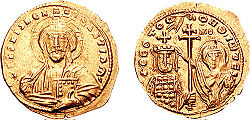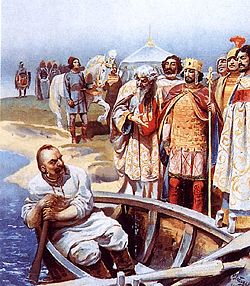John I Tzimiskes
| John I Tzimiskes | |
| Emperor of the Byzantine Empire | |
|---|---|
 |
|
| John, protected by God and the Virgin Mary. | |
| Reign | December 11, 969 – January 10, 976 |
| Born | circa 925 |
| Died | January 10, 976 |
| Place of death | Constantinople |
| Predecessor | Nikephorus II Phokas |
| Successor | Basil II |
| Consort | Theodora |
| Dynasty | Macedonian Dynasty |
John I Tzimiskes or Tzimisces, (Greek: Ιωάννης Α΄ Τζιμισκής, Iōannēs I Tzimiskēs; Armenian: Հովհաննես Ա Չմշկիկ, Armenian pronunciation: [hovhɑnnɛs tʃʰmʃkʼikʼ]; circa 925 - January 10, 976) was Byzantine Emperor from December 11, 969 to January 10, 976. A brilliant and intuitive general, John's short reign saw the expansion of the empire's borders and the strengthening of Byzantium itself.[1]
Contents |
Background
John was born into the Armenian Kourkouas family and his nickname was derived either from the Armenian tshemshkik, meaning "red boot," or from an Armenian word for "short stature." He was born sometime in 925 to an unnamed member of the Kourkouas family by the sister of the future Emperor Nikephoros II Phokas. Both the Kourkouai and the Phokadai were distinguished Cappadocian families of Armenian origin, and among the most prominent of the emerging military aristocracy of Asia Minor. Several of their members had served as prominent army generals.
Contemporary sources describe John as a rather short but well-built man, with reddish blonde hair and beard and blue eyes who was attractive to women.[2] He seems to have joined the army at an early age, originally under the command of his maternal uncle Nikephoros Phokas. The latter is also considered his instructor in the art of war. Partly because of his familiar connections and partly because of his personal abilities, John quickly rose through the ranks. He was given the political and military command of the theme of Armenia before he turned twenty-five years old. His marriage to Maria Skleraina linked him to the influential family of the Skleroi.
Rise to the throne
At the time the Empire was at war with its eastern neighbor, the Abbasid Empire. Armenia served as the borderland between the two Empires. John managed to successfully defend his province. He and his troops joined the main part of the army, which was campaigning against the enemy under the command of Nikephoros Phokas.
Nikephoros (which means "bearer of victory") justified his name with a series of victories, moving the borders further east with the capture of about 60 border cities including Aleppo. By 962, the Abbasids had asked for a peace treaty with favorable terms for Byzantines, that secured the borders for some years. John distinguished himself during the war both at the side of his uncle and at leading parts of the army to battle under his personal command. He was rather popular with his troops and gained a reputation for taking the initiative during battles, turning their course.
On the death of Emperor Romanos II in 963, John urged his uncle to seize the throne. After helping Nikephoros II to the throne and to continuing to defend the empire's eastern provinces, John was deprived of his command by an intrigue, for which he retaliated by conspiring with Nikephoros' wife Theophano to assassinate him.
Reign

After his coronation in December 969, John dispatched his brother-in-law Bardas Skleros to subdue a rebellion by Bardas Phokas, who aspired to succeed his uncle Nikephoros II. To solidify his position, John married Theodora, a daughter of Emperor Constantine VII. John proceeded to justify his usurpation by the energy with which he repelled the foreign invaders of the empire. In a series of campaigns against the Kievan encroachment on the Lower Danube in (970–971) he drove the enemy out of Thrace, crossed Mt. Haemus and besieged the fortress of Dorystolon (Silistra) on the Danube. In several hard-fought battles he defeated Prince Svyatoslav I of Kievan Rus so completely, that he left Tzimiskes master of eastern Bulgaria and Dobruja. On his return to Constantinople, Tzimiskes celebrated a triumph, divested the captive Bulgarian emperor Boris II of the imperial symbols, and proclaimed Bulgaria annexed. He further secured his northern frontier by transplanting to Thrace some colonies of Paulicians whom he suspected of sympathising with their Muslim neighbours in the east.
In 972 he turned against the Abbasid empire and its vassals, beginning with an invasion of Upper Mesopotamia. A second campaign, in 975, was aimed at Syria, where John's forces took Emesa, Baalbek, Damascus, Tiberias, Nazareth, Caesarea, Sidon, Beirut, Byblos and Tripoli, but failed to take Jerusalem. He died suddenly in 976 on his return from his second campaign against the Abbasids. Several sources state that the imperial chamberlain Basil Lekapenos poisoned the emperor to prevent him from stripping Lekapenos of his ill-gotten lands and riches.[3] John was succeeded by his ward and nephew, Basil II, who had been nominal co-emperor since 960.
Notes
Further reading
- The Oxford Dictionary of Byzantium, Oxford University Press, 1991.
- This article incorporates text from the Encyclopædia Britannica Eleventh Edition, a publication now in the public domain.
- Norwich, John J. (1991). Byzantium: The Apogee. Alfred A. Knopf, Inc..
External links
 Media related to John I Tzimisces at Wikimedia Commons
Media related to John I Tzimisces at Wikimedia Commons- Profile of Emperor John
- Coinage of Zimisces
|
John I Tzimiskes
Macedonian Dynasty
Born: c. 925 Died: 10 January 976 |
||
| Regnal titles | ||
|---|---|---|
| Preceded by Nikephoros II |
Byzantine Emperor 969–976 |
Succeeded by Basil II |
|
|||||||||||||||||||||||